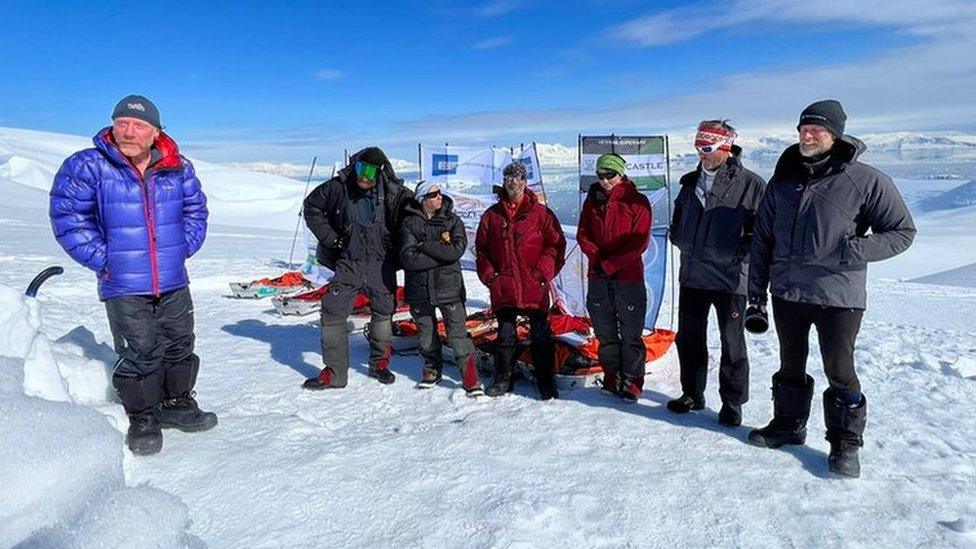Endurance 22: Antarctic expedition to search for Shackleton's wrecked ship
- Published
- comments

Antarctic Quest 21 held a ceremony on the Antarctic Peninsula in memory of Sir Ernest Shackleton
A lot is happening in Antarctica right now with two big expeditions underway.
And they both have a connection to famous explorer Sir Ernest Shackleton.
The first is being conducted by a group of scientists keen to learn more about how climate change is affecting the polar landscape.
The second is a special mission to find the remains of Shackleton's ship.
Read on to find out more about both.
Sir Ernest Shackleton and his crew were stuck in the Antarctic ice-floes aboard Endurance for 10 months in 1915 before a daring mission to get help
Antarctic Quest 21
The Antarctic Quest 21 team are there to study light levels and gather snow samples to study the extend of micro-plastic pollution there,
The researchers hope the data will inform scientists about the ozone layer and how far pollution has travelled across the world.
As part of the trip, a ceremony has taken place in memory of Sir Ernest Shackleton, the famous Antarctic explorer who died 100 years ago on 5 January 1922 during his final mission to the region.
The team, who set off from Plymouth in December just as Shackleton did 100 years ago, said the ceremony was for Shackleton and for every person who undertakes these feats to learn more about the planet.
100 years ago he was setting out on what was going to be a voyage of scientific exploration.
"He was very interested in protecting the polar regions so it only seems fitting 100 years on that we should commemorate someone whose work and life was dedicated to exploration, science and giving us a greater understanding of the planet we live on," said Paul Hart, Antarctic Quest 21's leader.
Endurance 22
Meanwhile, a second expedition - Endurance 22 - hopes to commemorate the centenary of Shackleton's death by uncovering the wreck of his ship, Endurance, which sank in 1915 after it was trapped in the ice.
If it's found, no attempt will be made to raise artefacts. The site is protected under the Antarctic treaty and is not to be disturbed
Estimated to be 2,000-3,000 metres below the surface, deep in the Weddell Sea, the expedition will attempt to use AI (Artificial Intelligence) to explore the seabed and try and find the remains of the ship.
The conditions are particularly challenging and all attempts so far to find the ship have proved unsuccessful.
Historian Dan Snow, who is aboard the expedition told the ґуПуґ«ГЅ it is "basically the most historic shipwreck in the world as yet undiscovered".
The Sabretooth robot can work autonomously or be controlled by fibre-optic tether and will scan the seabed for signs of the timber wreck
"We hope it's going to be in very good condition because it's extremely cold down there, it's very difficult for life forms to survive," he added.
Any life that might be found clinging to the old timbers could even be new species to be discovered, so there's a lot that could yet be uncovered by the submersible robots soon to be dropped into the deep.
Epic Endurance
The Endurance's ill-fated voyage marked the end of the "heroic age" of Antarctic exploration
The story of the Endurance and her crew is an epic one and all of Shackleton's crew survived the terrible conditions.
After spending ten months on ship - trapped in the ice, Shackleton and his crew abandoned it, living on top of the Antarctic ice for almost two years before, in April 1916, Shackleton took five crew members to find help.
They spent 16 days crossing 1,300km of ocean in a small boat with no navigating equipment to reach the island of South Georgia, where they trekked to a whaling station for help. He then went back to rescue all 22 men that he'd left behind, rescuing them on 30th August 1916.
- Published6 February 2023
- Published6 January 2020
